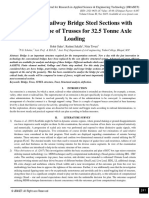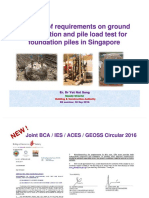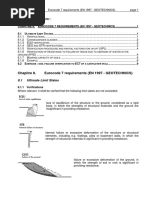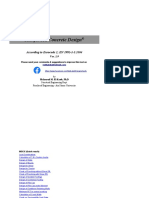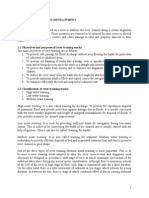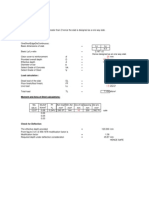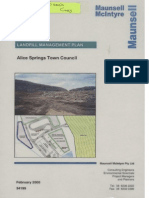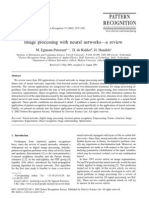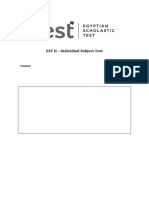0 ratings0% found this document useful (0 votes)
66 viewsElements of Soil Mechanics, 8th Edition Exercises 7.2 & 7.5
Elements of Soil Mechanics, 8th Edition Exercises 7.2 & 7.5
Uploaded by
ace1205This document describes a spreadsheet that contains exercises for designing gravity retaining walls using different limit state design methods, including factor of safety, Eurocode 7 EQU, and Eurocode 7 GEO approaches. The spreadsheet allows the user to input soil properties, wall dimensions, and other parameters and see the effect on the design results. Instructions are provided on using the spreadsheet to perform the designs.
Copyright:
© All Rights Reserved
Available Formats
Download as XLS, PDF, TXT or read online from Scribd
Elements of Soil Mechanics, 8th Edition Exercises 7.2 & 7.5
Elements of Soil Mechanics, 8th Edition Exercises 7.2 & 7.5
Uploaded by
ace12050 ratings0% found this document useful (0 votes)
66 views19 pagesThis document describes a spreadsheet that contains exercises for designing gravity retaining walls using different limit state design methods, including factor of safety, Eurocode 7 EQU, and Eurocode 7 GEO approaches. The spreadsheet allows the user to input soil properties, wall dimensions, and other parameters and see the effect on the design results. Instructions are provided on using the spreadsheet to perform the designs.
Original Description:
h
Original Title
Exercise 7.2
Copyright
© © All Rights Reserved
Available Formats
XLS, PDF, TXT or read online from Scribd
Share this document
Did you find this document useful?
Is this content inappropriate?
This document describes a spreadsheet that contains exercises for designing gravity retaining walls using different limit state design methods, including factor of safety, Eurocode 7 EQU, and Eurocode 7 GEO approaches. The spreadsheet allows the user to input soil properties, wall dimensions, and other parameters and see the effect on the design results. Instructions are provided on using the spreadsheet to perform the designs.
Copyright:
© All Rights Reserved
Available Formats
Download as XLS, PDF, TXT or read online from Scribd
Download as xls, pdf, or txt
0 ratings0% found this document useful (0 votes)
66 views19 pagesElements of Soil Mechanics, 8th Edition Exercises 7.2 & 7.5
Elements of Soil Mechanics, 8th Edition Exercises 7.2 & 7.5
Uploaded by
ace1205This document describes a spreadsheet that contains exercises for designing gravity retaining walls using different limit state design methods, including factor of safety, Eurocode 7 EQU, and Eurocode 7 GEO approaches. The spreadsheet allows the user to input soil properties, wall dimensions, and other parameters and see the effect on the design results. Instructions are provided on using the spreadsheet to perform the designs.
Copyright:
© All Rights Reserved
Available Formats
Download as XLS, PDF, TXT or read online from Scribd
Download as xls, pdf, or txt
You are on page 1of 19
Elements of Soil Mechanics, 8th Edition
Exercises 7.2 & 7.5
The worksheets in this spreadsheet illustrate the use of the Factor of Safety and the
Eurocode 7 EQU and GEO limit state design methods for the design of gravity retaining
walls.
Although the spreadsheet contains the data for Exercises 7.2 & 7.5 from the book, the
data may be changed so that the reader can see the effect of varying the soil properties,
retained height etc.
Instructions:
1. As the routines call data from the partial factors spreadsheet, a dialog box asking
whether to update the data will appear. To use the default Eurocode 7 partial factor
values, click "Don't Update". If, however, you have changed values in the partial factors
spreadsheet, click "Update".
2. Select Data input sheet and enter data. Results are displayed on other sheets.
Ian Smith, Sept 2005
The worksheets in this spreadsheet illustrate the use of the Factor of Safety and the
Eurocode 7 EQU and GEO limit state design methods for the design of gravity retaining
Although the spreadsheet contains the data for Exercises 7.2 & 7.5 from the book, the
data may be changed so that the reader can see the effect of varying the soil properties,
1. As the routines call data from the partial factors spreadsheet, a dialog box asking
whether to update the data will appear. To use the default Eurocode 7 partial factor
values, click "Don't Update". If, however, you have changed values in the partial factors
2. Select Data input sheet and enter data. Results are displayed on other sheets.
Depth to underside of base d
base
= 0.00 m
Thickness of base t
base
= 1.00 m
Height of wall above foundation h
wall
= 5.00 m
Breadth of base b
base
= 2.50 m
Breadth of top b
top
= 1.80 m
Concrete weight density
conc
= 23.50
kN/m
3
Water weight density
water
= 9.81
kN/m
3
Retained fill
Weight density
fill.dry
= 18.00
kN/m
3
Shearing resistance
fill
= 35.00
Effective cohesion c'
fill
= 0.00 kPa
Foundation soil
Weight density
fdn
= 18.00
kN/m
3
Shearing resistance
fdn
= 35.00
Effective cohesion c'
fdn
= 0.00 kPa
Applied surcharge q = 0.00 kPa
Enter values into blue fields.
Design Results:
EQU: Overturning 2.74 (OK)
GEO: Sliding: DA1, Cbntn 1: 2.76 (OK)
GEO: Sliding: DA1, Cbntn 2: 2.27 (OK) (Governs)
surcharge, q
b
base
h
wall
t
base
b
top
d
base
2
3
1
Lumped Factor of Safety
1. Sliding
Backfill
Active earth pressure coefficient Ka
d.fill
= 0.271
Angle of interface friction
d
= 23.45
Weight density
d.fill
= 18.000
Self-weight of wall:
Wall area 1, W
1
G
vk.1
= 32.90
Wall area 2, W
2
G
vk.2
= 169.20
Wall area 3, W
3
G
vk.3
= 58.75
Total: G
vk.wall
= 260.85
Active earth pressures
@ foundation
Active lateral earth pressure (fill) p
fdn1
= 24.39
Active lateral earth pressure (fndtn soil) p
fdn2
= 0.00
@ base
Active lateral earth pressure p
base
= 0
Active thrust behind wall (permanent - unfavourable)
Active earth pressure 1 P
a1
= 60.97
Active earth pressure 2 P
a2
= 0.00
Total horizontal thrust H
d
= 60.97
Sliding resistance
Horizontal resistance R
hd.base
= 113.15
Factor of safety against sliding = F
s
= 1.86
2. Overturning
Disturbing
Lever arms:
P
a
due to fill L
Pa
= 1.67
Moments:
Destabilising mmt due to fill M
dst1.b
= 101.62
Stabilising
Lever arms:
Wall area 1 L
wall1
= 0.47
Wall area 2
L
wall2
= 1.60
Wall area 3
L
wall3
= 1.25
Moments:
Stabilising mmt due to Area 1 M
stb1
= 15.35
Stabilising mmt due to Area 2 M
stb2
= 270.72
Stabilising mmt due to Area 3 M
stb3
= 73.44
Total stabilising moment M
stb
= 359.51
Factor of safety against overturning = F
o
= 3.54
1. Geometry
Wall dimensions:
height of sloping portion, h
sloping
h
sloping
= 4.00
Wall area 1, A
1
Area
1
= 1.40
Wall area 2, A
2
Area
2
= 7.20
Wall area 3, A
3
Area
3
= 2.50
Total: A
wall
= 11.10
2. Representative actions
Self-weight of wall:
Wall area 1, W
1
G
vk.1
= 32.90
Wall area 2, W
2
G
vk.2
= 169.20
Wall area 3, W
3
G
vk.3
= 58.75
Total: G
vk.wall
= 260.85
3. Characteristic material properties
Concrete weight density
k.conc
= 23.50
kN/m
3
Retained fill
Weight density
k.fill.dry
= 18.00
kN/m
3
Shearing resistance
k.fill
= 35.00
Effective cohesion c'
k.fill
= 0.00 kPa
Foundation soil
Weight density
k.fdn
= 18.00
kN/m
3
Shearing resistance
k.fdn
= 35.00
Effective cohesion c'
k.fdn
= 0.00 kPa
EQU Limit State - Overturning
1. Partial factors
On unfavourable actions/action effects
Permanent actions
G
= 1.10
Variable actions
Q
= 1.50
On favourable actions/action effects
Permanent actions
G.fav
= 0.90
Variable actions
Q.fav
= -
On material properties/resistances
Coefficient of shearing resistance
= 1.25
Effective cohesion
c
= 1.25
Weight density
= 1.00
2. Design geometry
Retained height of fill H
= 5.00
3. Design material properties:
Backfill
Angle of shearing resistance
d.fill
= 29.26
Effective cohesion c'
d.fill
= 0.00
Active earth pressure coefficient Ka
d.fill
= 0.286
Weight density
d.fill
= 18.000
Foundation soil
Angle of shearing resistance
d.fdn
= 29.26
Effective cohesion c'
d.fdn
= 0.00
Angle of interface friction
d.fdn
= 29.26
Active earth pressure coefficient Ka
d.fdn
= 0.286
Weight density
d.fdn
= 18.000
4. Design actions
Self-weight of wall (permanent - favourable)
Wall area 1, W
1
G
vd.1
= 29.61
Wall area 2, W
2
G
vd.2
= 152.28
Wall area 3, W
3
G
vd.3
= 52.88
Total: G
vd.wall
= 234.77
Active earth pressures
@ foundation
Active lateral earth pressure (fill) p
fdn1
= 25.74
Active lateral earth pressure (fndtn soil) p
fdn2
= 25.74
@ base
Active lateral earth pressure p
base
= 25.74
Active thrust behind wall (permanent - unfavourable)
Active earth pressure 1 G
hd1
= 70.79
Active earth pressure 2 G
hd2
= 0.00
Active thrust due to surcharge (variable - unfavourable)
Surcharge pressure 1 Q
hd1
= 0.00
Surcharge pressure 2 Q
hd2
= 0.00
5. Design effect of actions
Lever arms:
P
a
due to fill, G
hd1
L
Ghd1
= 1.67
P
a
due to fndtn soil, G
hd2
L
Ghd2
= 0.00
P
a
due to surcharge, Q
hd1
L
Qhd1
= 2.50
P
a
due to surcharge, Q
hd2
L
Qhd2
= 0.00
Moments:
Destabilising mmt due to fill M
dst1
= 117.98
Destabilising mmt due to fndtn soil M
dst2
= 0.00
Destabilising mmt due to surcharge, Q
hd1
M
dst3
= 0.00
Destabilising mmt due to surcharge, Q
hd2
M
dst4
= 0.00
Total destabilising moment M
dst
= 117.98
Effect of actions E
dst
= 117.98
6. Design resistance
Lever arms:
Wall area 1 L
wall1
= 0.47
Wall area 2
L
wall2
= 1.60
Wall area 3
L
wall3
= 1.25
Moments:
Stabilising mmt due to Area 1 M
stb1
= 13.82
Stabilising mmt due to Area 2 M
stb2
= 243.65
Stabilising mmt due to Area 3 M
stb3
= 66.09
Total stabilising moment M
stb
= 323.56
7. Verification of overturning resistance
Overdesign factor
Ratio of resistance to effects = 2.74
Degree of utilisation
Proportion of available resistance used = 36%
7. Verification of overturning resistance
Overdesign factor
Ratio of resistance to effects = 2.74
Degree of utilisation
Proportion of available resistance used = 36.5%
red= from Partial Factors table
GEO Limit State - Sliding Design Approach 1, Combination 1
A1+M1+R1
1. Partial factors
On unfavourable actions/action effects
Permanent actions
G
= 1.35
Variable actions
Q
= 1.50
On favourable actions/action effects
Permanent actions
G.fav
= 1.00
Variable actions
Q.fav
= -
On material properties/resistances
Coefficient of shearing resistance
= 1.00
Effective cohesion
c
= 1.00
Weight density
= 1.00
Bearing resistance
Rv
= 1.00
Sliding resistance
Rh
= 1.00
2. Design geometry
Retained height of fill H
= 5.00
3. Design material properties:
Backfill
Angle of shearing resistance
d.fill
= 35.00
Effective cohesion c'
d.fill
= 0.00
Weight density
d.fill
= 18.000
Active earth pressure coefficient Ka
d.fill
= 0.218
Foundation soil
Angle of shearing resistance
d.fdn
= 35.00
Effective cohesion c'
d.fdn
= 0.00
Weight density
d.fdn
= 18.000
Angle of interface friction
d.fdn
= 35.00
Active earth pressure coefficient Ka
d.fdn
= 0.218
4. Design actions
Self-weight of wall (permanent - favourable)
Wall area 1, W
1
G
vd.1
= 32.90
Wall area 2, W
2
G
vd.2
= 169.20
Wall area 3, W
3
G
vd.3
= 58.75
Total: G
vd.wall
= 260.85
Active earth pressures
@ foundation
Active lateral earth pressure (fill) p
fdn1
= 19.62
Active lateral earth pressure (fndtn soil) p
fdn2
= 19.62
@ base
Active lateral earth pressure p
base
= 19.62
Active thrust behind wall (permanent - unfavourable)
Active earth pressure 1 G
hd1
= 66.22
Active earth pressure 2 G
hd2
= 0.00
Active thrust due to surcharge (variable - unfavourable)
Surcharge pressure 1 Q
hd1
= 0.00
Surcharge pressure 2 Q
hd2
= 0.00
5. Design effect of actions
Total horizontal thrust H
d
= 66.22
Effect of actions E
hd
= 66.22
6. Design resistance
Friction on underside of base
Vertical action (total) V
d
= 260.85
Horizontal resistance R
hd
= 182.65
7. Verification of sliding resistance
Overdesign factor
Ratio of resistance to effects = 2.76
Degree of utilisation
Proportion of available resistance used = 36%
Design Approach 1, Combination 1
7. Verification of sliding resistance
Overdesign factor
Ratio of resistance to effects = 2.76
Degree of utilisation
Proportion of available resistance used = 36.3%
red= from Partial Factors table
GEO Limit State - Sliding Design Approach 1, Combination 2
A2+M2+R1
1. Partial factors
On unfavourable actions/action effects
Permanent actions
G
= 1.00
Variable actions
Q
= 1.30
On favourable actions/action effects
Permanent actions
G.fav
= 1.00
Variable actions
Q.fav
= -
On material properties/resistances
Coefficient of shearing resistance
= 1.25
Effective cohesion
c
= 1.25
Weight density
= 1.00
Bearing resistance
Rv
= 1.00
Sliding resistance
Rh
= 1.00
2. Design geometry
Retained height of fill H
= 5.00
3. Design material properties:
Backfill
Angle of shearing resistance
d.fill
= 29.26
Effective cohesion c'
d.fill
= 0.00
Weight density
d.fill
= 18.000
Active earth pressure coefficient Ka
d.fill
= 0.286
Foundation soil
Angle of shearing resistance
d.fdn
= 29.26
Effective cohesion c'
d.fdn
= 0.00
Weight density
d.fdn
= 18.000
Angle of interface friction
d.fdn
= 29.26
Active earth pressure coefficient Ka
d.fdn
= 0.286
4. Design actions
Self-weight of wall (permanent - favourable)
Wall area 1, W
1
G
vd.1
= 32.90
Wall area 2, W
2
G
vd.2
= 169.20
Wall area 3, W
3
G
vd.3
= 58.75
Total: G
vd.wall
= 260.85
Active earth pressures
@ foundation
Active lateral earth pressure (fill) p
fdn1
= 25.74
Active lateral earth pressure (fndtn soil) p
fdn2
= 25.74
@ base
Active lateral earth pressure p
base
= 25.74
Active thrust behind wall (permanent - unfavourable)
Active earth pressure 1 G
hd1
= 64.35
Active earth pressure 2 G
hd2
= 0.00
Active thrust due to surcharge (variable - unfavourable)
Surcharge pressure 1 Q
hd1
= 0.00
Surcharge pressure 2 Q
hd2
= 0.00
5. Design effect of actions
Total horizontal thrust H
d
= 64.35
Effect of actions E
hd
= 64.35
6. Design resistance
Friction on underside of base
Vertical action (total) V
d
= 260.85
Horizontal resistance R
hd
= 146.12
7. Verification of sliding resistance
Overdesign factor
Ratio of resistance to effects = 2.27
Degree of utilisation
Proportion of available resistance used = 44%
Design Approach 1, Combination 2
7. Verification of sliding resistance
Overdesign factor
Ratio of resistance to effects = 2.27
Degree of utilisation
Proportion of available resistance used = 44.0%
red= from Partial Factors table
This spreadsheet has been downloaded from the website that supports
Smith's Elements of Soil Mechanics, 8th Edition
Published by Blackwell Publishing, May 2006
ISBN: 1-4051-3370-8
Visit the website:
http://sbe.napier.ac.uk/esm
Purchase the book:
(Blackwell Publishing website)
http://sbe.napier.ac.uk/esm
Please note:
This spreadsheet is an aid for learning and should really only be
used in conjunction with the relevant section in the book.
It is not intended for use in geotechnical design.
Ian Smith, May 2006
You might also like
- Rectangular Tank CalculationDocument28 pagesRectangular Tank CalculationHiếu Nguyên79% (34)
- Swimming Pool Design SheetDocument48 pagesSwimming Pool Design Sheetआई एम ओ.के.94% (17)
- Grammar Explorer 2 - Unit 3Document28 pagesGrammar Explorer 2 - Unit 3pinpollo 507No ratings yet
- Design of Reinforced Concrete Water TanksDocument71 pagesDesign of Reinforced Concrete Water Tanksace1205100% (3)
- How To Calculate Slab Steel Quantity From Drawing Excel SheetDocument15 pagesHow To Calculate Slab Steel Quantity From Drawing Excel SheetJeany NoquilloNo ratings yet
- EC7 Fundamental Issues and Its Implications On Users PDFDocument24 pagesEC7 Fundamental Issues and Its Implications On Users PDFVardhanNo ratings yet
- CE6102 - 5 - Application of Newton Raphson Techniques To Elasto-Plastic Model With Constant Yield SurfacesDocument9 pagesCE6102 - 5 - Application of Newton Raphson Techniques To Elasto-Plastic Model With Constant Yield SurfacesandreashendiNo ratings yet
- Beam On Elastic FoundationDocument8 pagesBeam On Elastic Foundationgorakdias50% (2)
- APICE - Manuale TERP3Document56 pagesAPICE - Manuale TERP3GiuseppeProiettiNo ratings yet
- Cantilever Retaining WallDocument20 pagesCantilever Retaining WallParvatha Vardhan GandrakotaNo ratings yet
- Designing A Steel Beam: Icon LegendDocument5 pagesDesigning A Steel Beam: Icon LegendAlina ShresthaNo ratings yet
- EC2 Ch03aDocument15 pagesEC2 Ch03asunilarunaNo ratings yet
- Volume 2 Highways Structures: Design (Substructures and Special Structures), Materials Section 2 Special StructuresDocument86 pagesVolume 2 Highways Structures: Design (Substructures and Special Structures), Materials Section 2 Special Structuresgeorge santiagoNo ratings yet
- Elements of Soil Mechanics, 9th Edition Exercise 8.4: Ian Smith, June 2014Document11 pagesElements of Soil Mechanics, 9th Edition Exercise 8.4: Ian Smith, June 2014PreethiNo ratings yet
- Some Geotechnical Properties of Tokai Clay PaperDocument6 pagesSome Geotechnical Properties of Tokai Clay PaperSen HuNo ratings yet
- CE2112 Concepts of Stresses and Strains PPT HandoutsDocument14 pagesCE2112 Concepts of Stresses and Strains PPT HandoutsSteven KuaNo ratings yet
- Analysis Example With EC7: Water 3 3 DRY 3Document17 pagesAnalysis Example With EC7: Water 3 3 DRY 3Chris LumyNo ratings yet
- Pe's CalDocument27 pagesPe's CalSơn Nguyễn-LêNo ratings yet
- Strut and Tie Model (STM) IntroductionDocument8 pagesStrut and Tie Model (STM) IntroductionsaharuiNo ratings yet
- Seismic Design To EC8 - L3Document18 pagesSeismic Design To EC8 - L3Chamil MahagamageNo ratings yet
- 16 - Bruce Ireland - Joint DetailsDocument32 pages16 - Bruce Ireland - Joint DetailsTian NgNo ratings yet
- Excavation Induced Building DamageDocument5 pagesExcavation Induced Building DamageMarco Dos Santos NevesNo ratings yet
- Soil-Structure Interaction. Underground Structures and Retaining WallsDocument10 pagesSoil-Structure Interaction. Underground Structures and Retaining WallsMark Lester Brosas TorreonNo ratings yet
- Stability AnalysisDocument6 pagesStability AnalysisDaanyal UmarNo ratings yet
- What Is A Slab? 2. Two Types of SlabDocument18 pagesWhat Is A Slab? 2. Two Types of SlabCian ChanNo ratings yet
- 2023 - Potini - Rigorous Lower and Upper Bounds For The Generalised FailureDocument7 pages2023 - Potini - Rigorous Lower and Upper Bounds For The Generalised FailureValerioNo ratings yet
- Analysis of Railway Bridge Steel Sections With Different Type of Trusses For 32.5 Tonne Axle LoadingDocument10 pagesAnalysis of Railway Bridge Steel Sections With Different Type of Trusses For 32.5 Tonne Axle LoadingIJRASETPublicationsNo ratings yet
- CH 6 Tutorial 2016Document5 pagesCH 6 Tutorial 2016Steven KuaNo ratings yet
- Ultimate Limit State Design of Retaining Walls With Numerical MethodsDocument6 pagesUltimate Limit State Design of Retaining Walls With Numerical MethodsGys AnamaliNo ratings yet
- Design Considerations For One-Strut Failure According To TR26 - A Practical Approach For Practising EngineersDocument17 pagesDesign Considerations For One-Strut Failure According To TR26 - A Practical Approach For Practising EngineersrrprasathNo ratings yet
- CIV 4235 ExamDocument9 pagesCIV 4235 Exammalumius100% (2)
- Report High Rise BuildingDocument33 pagesReport High Rise BuildingChiranjaya HulangamuwaNo ratings yet
- A Review of Requirements On Ground Investigation and Load Test For Foundation Piles in SingaporeDocument72 pagesA Review of Requirements On Ground Investigation and Load Test For Foundation Piles in SingaporeChong Hong RuiNo ratings yet
- SoilMech Ch8 EC7 RequirementsDocument10 pagesSoilMech Ch8 EC7 RequirementsarslanpasaNo ratings yet
- CV6311 Shear Strength Lect2 2012Document53 pagesCV6311 Shear Strength Lect2 2012ikanyu79No ratings yet
- Preliminary Design of BRBF System: Use of Equivalent Lateral Force MethodDocument11 pagesPreliminary Design of BRBF System: Use of Equivalent Lateral Force MethodJacky TamNo ratings yet
- Support Design Calculations 16-05-2019Document15 pagesSupport Design Calculations 16-05-2019syed saleemNo ratings yet
- Plaxis 2DDocument13 pagesPlaxis 2DVo Dinh ThaoNo ratings yet
- Bill Mosley John Bungey & Ray Hulse: Reinforced Concrete Design To EC2Document36 pagesBill Mosley John Bungey & Ray Hulse: Reinforced Concrete Design To EC2RyanWongJiaHanNo ratings yet
- Strip Footing ExampleDocument5 pagesStrip Footing ExampleBunkun15No ratings yet
- Design Spectrum According To Eurocode 8Document6 pagesDesign Spectrum According To Eurocode 8BN NGNo ratings yet
- BS 8110-1997 PT-SL Example 001Document6 pagesBS 8110-1997 PT-SL Example 001Aashu chaudharyNo ratings yet
- BQS552 Earth Retaining StructureDocument93 pagesBQS552 Earth Retaining StructureShakir ZufayriNo ratings yet
- Mat Foundation Y Dir Rebar DesignDocument4 pagesMat Foundation Y Dir Rebar DesignGaneshalingam Ramprasanna2No ratings yet
- Fatigue Worked ExampleDocument2 pagesFatigue Worked ExampleAndrei Răzvan SecuNo ratings yet
- Differences Between CP4 and Eurocode 7: Background of Singapore Codes of PracticeDocument15 pagesDifferences Between CP4 and Eurocode 7: Background of Singapore Codes of PracticeSantosoNo ratings yet
- Column Splices Not Requiring Full Continuity of StiffnessDocument6 pagesColumn Splices Not Requiring Full Continuity of StiffnessBobaru MariusNo ratings yet
- Nota Design Using Ec2 2Document119 pagesNota Design Using Ec2 2mon100% (1)
- Bearing Capacity of Pile Foundation & Construction) - TinSoeDocument78 pagesBearing Capacity of Pile Foundation & Construction) - TinSoeBluebelgianNo ratings yet
- Design Rules and Formulae 2023Document55 pagesDesign Rules and Formulae 2023madhurjoNo ratings yet
- RC Design EC2 v1.9Document64 pagesRC Design EC2 v1.9mohammed alebiedNo ratings yet
- A Final Report OnDocument44 pagesA Final Report Onpawan bhattaraiNo ratings yet
- 116 Pavilion Road STS - 19 - CTMPDocument26 pages116 Pavilion Road STS - 19 - CTMPmarkomarkomarkomarkoNo ratings yet
- Tann Designs & Engineers: Welding Design CheckDocument1 pageTann Designs & Engineers: Welding Design CheckSiva JaseNo ratings yet
- CE3155 Introduction To ETABS (Multi-Storey)Document42 pagesCE3155 Introduction To ETABS (Multi-Storey)Imran SaikatNo ratings yet
- Behavior of Piles With Raft Foundation Using Safe Software: Reshma T.V, Bhavya B S, Rashmi Mishra, Sankalpasri S SDocument5 pagesBehavior of Piles With Raft Foundation Using Safe Software: Reshma T.V, Bhavya B S, Rashmi Mishra, Sankalpasri S Sfrog15No ratings yet
- Reinforced Concrete Column by Zinab EC2Document15 pagesReinforced Concrete Column by Zinab EC2berto2008No ratings yet
- Assignment #4Document2 pagesAssignment #4Aly Arquillano JrNo ratings yet
- Presentation 11 - Slenderness EffectDocument39 pagesPresentation 11 - Slenderness EffectseaklengNo ratings yet
- BS 8110-97 PT-SL-001Document6 pagesBS 8110-97 PT-SL-001Merin OshwelNo ratings yet
- Calculation Deflection in Accordance To EC-2: 1.1 Design DataDocument15 pagesCalculation Deflection in Accordance To EC-2: 1.1 Design DataMisgun SamuelNo ratings yet
- Materials Engineering: Pangasinan State University Urdaneta Campus Mechanical Engineering DepartmentDocument7 pagesMaterials Engineering: Pangasinan State University Urdaneta Campus Mechanical Engineering DepartmentiamjemahNo ratings yet
- Elements of Soil Mechanics, 8th Edition Exercises 7.2 & 7.5Document19 pagesElements of Soil Mechanics, 8th Edition Exercises 7.2 & 7.5Franklyn GenoveNo ratings yet
- Example: Gravity Retaining Wall: 1.8 M Surcharge, Q 20 KpaDocument5 pagesExample: Gravity Retaining Wall: 1.8 M Surcharge, Q 20 KpaMadhu KumarNo ratings yet
- Gravity Wall Verification Manual enDocument26 pagesGravity Wall Verification Manual enradem3No ratings yet
- Chapter 8 PDFDocument30 pagesChapter 8 PDFace1205No ratings yet
- Research ProposalDocument1 pageResearch Proposalace1205No ratings yet
- Leachate TreatmentDocument14 pagesLeachate Treatmentace1205No ratings yet
- Hydraulic Structures II-1Document51 pagesHydraulic Structures II-1ace1205100% (2)
- Tank CalculatorDocument19 pagesTank Calculatorace1205No ratings yet
- Base Pad Width (Perp. To Sail)Document1 pageBase Pad Width (Perp. To Sail)ace1205No ratings yet
- Design of SlabDocument3 pagesDesign of Slabace1205No ratings yet
- Steel TankDocument75 pagesSteel Tankace1205No ratings yet
- Tank Spreadsheet V 6 ADocument88 pagesTank Spreadsheet V 6 Aace1205100% (1)
- Stresses Due To Fluid Pressure in Thin CylindersDocument25 pagesStresses Due To Fluid Pressure in Thin Cylindersace1205No ratings yet
- Api 650 2007Document449 pagesApi 650 2007ace1205100% (4)
- API 650 Tank Nozzle Stand OutDocument5 pagesAPI 650 Tank Nozzle Stand Outace1205No ratings yet
- Landfill Management PlanDocument125 pagesLandfill Management Planace1205No ratings yet
- Proposed Upwader Wastewater Treatment-3D Diagram of The Bar Screen and Grit ChamberDocument1 pageProposed Upwader Wastewater Treatment-3D Diagram of The Bar Screen and Grit Chamberace1205No ratings yet
- Tym t450 Service ManualDocument20 pagesTym t450 Service ManualElaine100% (64)
- Blue Fire Light - PanelDocument5 pagesBlue Fire Light - PanelKevin GuerraNo ratings yet
- Diesel Engine Tune-UpDocument58 pagesDiesel Engine Tune-Upace ebradoNo ratings yet
- Week 13 Thyroid GlandDocument13 pagesWeek 13 Thyroid GlandAlyhana MedinaNo ratings yet
- Mathematics Paper 1 TZ2 HLDocument19 pagesMathematics Paper 1 TZ2 HLsohamNo ratings yet
- Syllabus Class VI30052017083058 PDFDocument11 pagesSyllabus Class VI30052017083058 PDFGaneshNo ratings yet
- RPT Math Form 2Document16 pagesRPT Math Form 2Hartini KosnanNo ratings yet
- The Theosophist Vol 144. No. 1Document44 pagesThe Theosophist Vol 144. No. 1Abraham SolomonNo ratings yet
- Seow Koji Takehira 0320816-CompressedDocument23 pagesSeow Koji Takehira 0320816-Compressedapi-302702920No ratings yet
- KR 6 R1820 Arc HW: Teach PendantDocument1 pageKR 6 R1820 Arc HW: Teach PendantAHMED ghribiNo ratings yet
- Pathfit EssayDocument8 pagesPathfit Essayjeffmyself901No ratings yet
- VVVVDocument1 pageVVVVSanjoy SanyalNo ratings yet
- Chem PDFDocument96 pagesChem PDFNikhilNo ratings yet
- 2014 Naples Daily News Hurricane GuideDocument44 pages2014 Naples Daily News Hurricane GuidevonnasworldNo ratings yet
- RESEARCHALOG-BACULINA-ALIMAN EDITED With Chapter 1235 Appendices and ReferencesDocument29 pagesRESEARCHALOG-BACULINA-ALIMAN EDITED With Chapter 1235 Appendices and ReferencesdelfinjagolinoNo ratings yet
- Gastrointestinal Study GuideDocument2 pagesGastrointestinal Study GuideShannaNo ratings yet
- Fiche Technique FT53027Document1 pageFiche Technique FT53027MateusNo ratings yet
- Image Processing With Neural Networks-A Review: M. Egmont-Petersen, D. de Ridder, H. HandelsDocument23 pagesImage Processing With Neural Networks-A Review: M. Egmont-Petersen, D. de Ridder, H. HandelsŘŎХ MashNo ratings yet
- Huawei HyperMetro Solution Optimal Configuration 02Document1 pageHuawei HyperMetro Solution Optimal Configuration 02VVLNo ratings yet
- TestBank ch01Document25 pagesTestBank ch01Edison BajramajNo ratings yet
- Soal UlanganDocument6 pagesSoal Ulanganluhkusnita58No ratings yet
- UntitledDocument2 pagesUntitledBanana QNo ratings yet
- 5 Tips To Write Successful Ambient Guitar Looping SongsDocument11 pages5 Tips To Write Successful Ambient Guitar Looping Songsitemcode23100% (1)
- History of AppetizerDocument10 pagesHistory of AppetizerErika Therese P. PadillaNo ratings yet
- O&M of HVDC Station - PowerGrid IndiaDocument58 pagesO&M of HVDC Station - PowerGrid IndiaUmamaheshwarrao Varma0% (1)
- SW Mock 2024 - O AND A LEVEL GENERAL TIMETABLE FINALDocument1 pageSW Mock 2024 - O AND A LEVEL GENERAL TIMETABLE FINALfavourhighness22No ratings yet
- Chemistry ESTDocument97 pagesChemistry ESTsjood.alefredobooks98No ratings yet


























